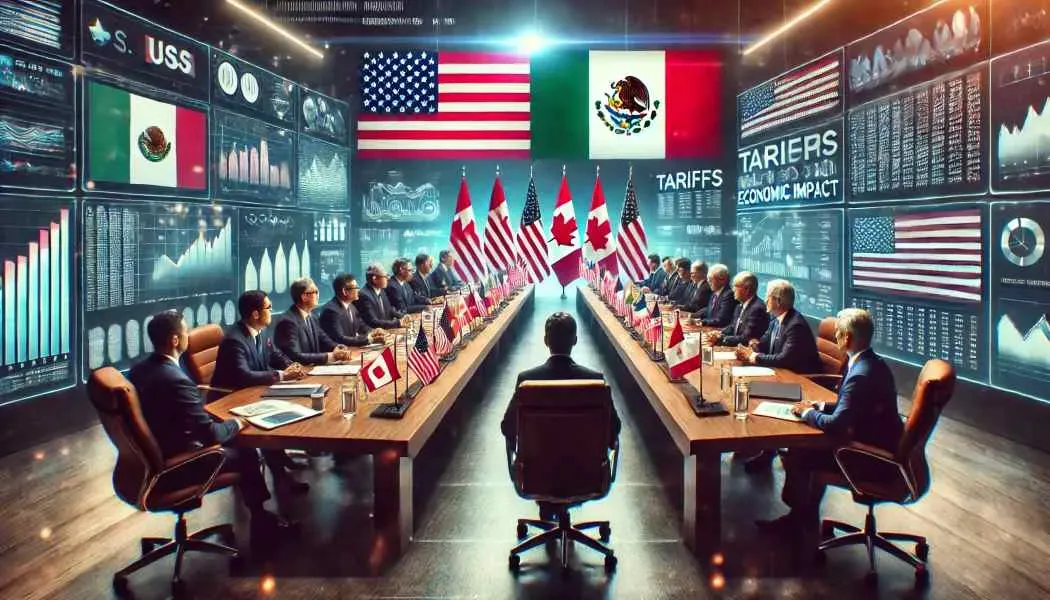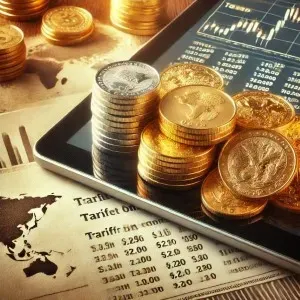
U.S. Tariff Plan Moves Forward Amid Rising Tensions
With the March 4, 2025, deadline approaching, President Donald Trump’s tariff plan on Canadian and Mexican imports is moving forward despite ongoing negotiations. The proposed 25% tariff on most imported goods from both countries—along with a 10% tariff on Canadian energy products—has sparked sharp opposition from U.S. trade partners.
While Trump justifies these tariffs as measures to curb illegal immigration, address fentanyl smuggling, and correct trade imbalances, both Canada and Mexico have rejected the plan and are preparing to respond with retaliatory tariffs. As fears of a trade war grow, global markets are on edge, and investors are closely monitoring the potential impact on supply chains, commodity prices, and economic stability.
Why Is Trump Implementing New Tariffs?
The Trump administration argues that these tariffs are necessary to protect American industries, reduce reliance on foreign manufacturing, and strengthen national security. The White House claims that Canadian and Mexican imports have led to unfair trade conditions, harming U.S. manufacturing, steel, and agriculture.
Key Justifications for the Tariffs:
- Border Security & Immigration Control – The administration believes trade restrictions will pressure Mexico to increase border security and curb illegal immigration into the U.S.
- Fentanyl Trafficking – Trump has accused Mexico and Canada of failing to stop fentanyl production and smuggling into the U.S., making trade penalties a tool for policy enforcement.
- Trade Deficit Reduction – Higher tariffs are expected to incentivize companies to relocate manufacturing jobs back to the U.S., reducing dependence on foreign imports.
- Addressing Unfair Trade Practices – The administration contends that foreign governments subsidize their industries, creating an uneven playing field for U.S. businesses.
While the White House sees tariffs as an economic safeguard, many analysts warn that they will result in higher consumer prices, economic uncertainty, and potential job losses in export-dependent industries.
Canada and Mexico Respond: Will Retaliatory Tariffs Follow?
Both Canada and Mexico have made it clear that if the U.S. tariffs are enacted, they will respond with their own trade restrictions. Canadian Prime Minister Justin Trudeau has warned of counter-tariffs on American goods, while Mexico’s President Claudia Sheinbaum has confirmed that Mexico will impose economic countermeasures to protect its domestic industries.
Potential Canadian Tariffs:
- Higher tariffs on U.S. agricultural exports, including beef, dairy, and poultry.
- Increased taxes on American-made automobiles entering Canada.
- Possible energy trade restrictions, affecting U.S. access to Canadian oil and gas.
Potential Mexican Tariffs:
- Higher duties on American corn, soybeans, and wheat, which are vital to the Mexican economy.
- Tariffs on U.S. industrial goods, machinery, and electronics.
- Restrictions on American auto exports, potentially impacting U.S. car manufacturers.
A full-scale trade war between the U.S., Canada, and Mexico could have long-term economic consequences, particularly for industries that depend on North American supply chains.
Trump’s April Tariff Plan: A Global Trade War?
Beyond Canada and Mexico, Trump is also targeting other global trade partners with a new round of tariffs set to begin in April 2025. These tariffs are intended to match or exceed the rates imposed by foreign nations on U.S. goods.
Unlike previous tariffs, these new measures will factor in other trade barriers, such as:
- Government subsidies that artificially lower prices for foreign competitors.
- Regulatory barriers that make it difficult for American goods to enter foreign markets.
- Value-added taxes (VAT), which are commonly used in Europe and Asia as a form of taxation on imports.
By including these elements in the calculations, the new tariffs could be even higher than current foreign trade restrictions, significantly raising import costs in the U.S.
How Could This Escalate into a Global Trade War?
If the U.S. raises tariffs aggressively, it is likely that other global economies will retaliate. The European Union (EU) has already hinted that it may introduce countermeasures against U.S. exports, potentially targeting American cars, tech products, and agricultural goods.
Potential Global Economic Consequences:
- Higher Costs for Consumers – As trade barriers increase, goods imported into the U.S. will become more expensive, leading to inflationary pressure.
- Supply Chain Disruptions – Industries such as automotive, technology, and energy may experience shortages and delays.
- Market Volatility – The uncertainty surrounding a trade war could cause fluctuations in stock markets, commodities, and investor confidence.
Precious Metals and Cryptocurrency Market Impact
Periods of economic uncertainty often lead investors to seek safe-haven assets, and gold, silver, and Bitcoin could see increased demand. If tariffs disrupt trade, increase inflation, or slow economic growth, precious metals and cryptocurrencies may become even more attractive to investors.
Gold & Silver Outlook:
- Gold prices could rise as investors turn to hedges against inflation and currency devaluation.
- Silver demand could grow, especially if industrial production faces disruptions.
- Platinum and palladium may experience volatility, as they are critical metals in automobile production.
Cryptocurrency Trends:
- Bitcoin and Ethereum may benefit if investors lose confidence in traditional markets.
- Stablecoins like PAX Gold (PAXG) could gain traction as alternatives to fiat currencies in uncertain economic times.
Preparing for Market Uncertainty
With the March 4 tariff deadline fast approaching and global trade measures expected in April, markets are bracing for potential disruptions. While Canada and Mexico prepare retaliatory tariffs, the EU and other nations are also considering countermeasures.
For investors, gold, silver, and Bitcoin could be key assets in hedging against economic instability. Bullion Hunters will continue to provide updates on the impact of these tariffs on precious metals, global trade, and financial markets.
Another article that may interest you:
How Trump’s EU Tariff Plan Could Shake Up Precious Metals

